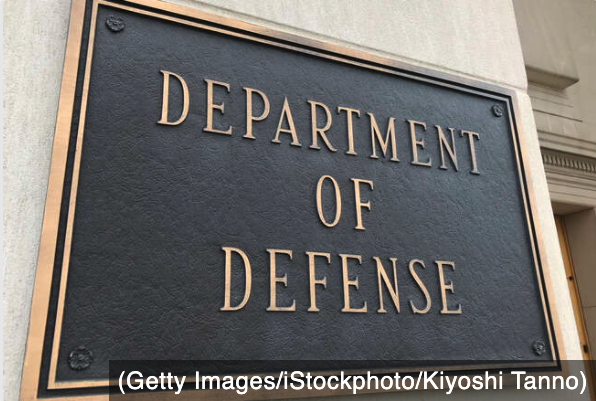Best listening experience is on Chrome, Firefox or Safari. Subscribe to Federal Drive’s daily audio interviews on Apple Podcasts or PodcastOne.
Pentagon acquisition might not animate dinner party conversations. But it’s a hugely important topic in military planning circles, and it generates reams of articles each year. That’s why, each year, the Army backs a program known as the Major General Harry Greene Awards for Acquisition Writing. Among the winners of the most recent round is a professor at Defense Acquisition University. Dave Riel joined Federal Drive with Tom Temin.
Interview transcript:
Tom Temin: Mr. Riel good to have you on.
Insight by ThunderCat Technology and Dell Technologies: Learn different ways agencies are taking more advantage of AI and ML tools to help exceed mission expectations by downloading this exclusive e-book.
David Riel: Great, Tom. Thank you.
Tom Temin: And we should point out that Major General Harry Greene was involved in engineering and logistics and was killed in Afghanistan in 2014, one of the highest ranking people, maybe the highest ranking people to die there overseas. So it has a good lineage, this writing contest. But let’s begin with your article that won in this year’s round of awards. I’ll let you explain what you were writing about better than if I try to paraphrase it.
David Riel: Yeah, sure. So one of the things that we’ve seen recognized in recent years is the need to innovate quicker. And it’s interesting, because obviously there’s many differences between the Trump and the Biden administration, but one place where we find some solid agreement is on the threat that China poses, as well as the need to tap into the innovation that has always been America’s strength. And we’ve seen that from both the executive branch and legislative branch perspective, if we look back at the Trump administration, in their national security strategy, they make very clear that we need to approach acquisition differently so that we can harness those innovative technologies that are being developed outside our traditional defense industrial base. And if we go further, you know, just in 2018, when the new national defense strategy came out, Secretary of Defense Mattis came out and again made that point that those rapid technology advancements that gave us our advantages in the past are being offset, because those advantages are percolating now in the commercial realm. And he went on to say that the interstate strategic competition, specifically naming China and Russia, not terrorism, as now the primary concern of the US national security. So that’s what really drove me wanting to look a little bit deeper into this issue, and try to develop some ways or think of some ways where we could stimulate that innovative mindset in the Department of Defense.
Tom Temin: Because for a number of years, there have been efforts like this, there is the defense innovation unit, the DIUX, I think it’s called and they’re all of these rapid acquisition experiments in the armed services. And there is increasing use of other transaction authorities to get prototypes done. So it sounds like you sense that there’s still a missing ingredient to rapidly accessing some of the innovation going on out there, between here and the West Coast.
David Riel: I agree. And we’re really proud of that. And Department of Defense has some organizations like AFWERX and SOFWERX, and as you mentioned, DIU. You know, and frankly, Congress has been doing their part as well, I mean, we can look back to the National Defense Authorization Act of 2016 and see innovations like authorities to expand our other transactional authority, which gives us the opportunity to reach out to small non traditional defense companies a little easier. Things like new acquisition pathways, specifically one known as the middle tier of acquisition, which was designed to allow the DoD to better rapidly prototype and feel new improvement technologies by taking away some of those traditional requirements that we had, like deliberate user requirement system known as JSIDS, or even the governing regulations on acquisitions, or DoD 5000 series. And those are huge. And even as recently as last year in 2020, you know, we saw the National Defense Authorization Act put into law, the DoD’s use of commercial software methodologies, you know, that we often refer to as agile. So it’s all these reasons I think, Ms. Lorde, who was USD acquisition sustainment lead chief until recently had it right when she said, this is, you know, the most transformational reform of acquisition in decades. I’ve been in this business for more than 30 years now and lived through a lot of acquisition reform. But this is the first where the primary focus has been on schedule instead of cost.
Tom Temin: Sure. We’re speaking with Dave Riel. He’s a professor at Defense Acquisition University and a winner in this year’s Major General Harry Greene Awards for Acquisition Writing, sponsored by the army. So is the essential problem here finding the innovation and adapting it to defense use? Or is it having defense requirements, and then finding innovative suppliers that can meet them, which are not exactly the same thing?
David Riel: Yeah. Again, I think they’re similar. I think that it’s that connection that needs to be made. And what my article approaches and hopes to stimulate some thought on is how do we capitalize more on those innovations in small companies by instead of just allowing them to compete for defense contracts, but actually seeking them, recruiting them, rewarding them and stimulating them to become part of the solutions that we’re looking for.
Tom Temin: Because one of the challenges I think in doing so would be that they have to understand, well, you can’t also sell it to China. And so the incentives and the reward system have to align in some way, because to fulfill that entrepreneurial spirit, a lot of them start because eventually they want to Get Rich doing so. So how do you work that dynamic?
David Riel: Yeah. And that’s a challenge, right? Obviously, not all of the technology that we need to be developed is applicable to commercial application. And also, as you said, there are security concerns. But we need to do our part as far as ensuring that we provide good financial and intelligent property incentives, so that it allows us to get to where we need to be. And you’ve probably heard this expression, the speed of relevance, right? And that’s what this article addresses, like how relevant is speed? And if you buy into the argument that we’re going to maintain a technological superiority needed by our warfighters in the deterrence, nearby diplomacy, frankly, we’ve got to capitalize on our commercial advances. The question becomes more of how we do that than if we do that.
Tom Temin: And in some ways, maybe the defense requirements can flow back stream or to the left, whenever you want to say ,beyond the supplier base to academic research, and the types of engineering programs that happen in the places that are excellent, at engineering.
David Riel: Yeah, that’s exactly right. And that’s where structurally, China has an advantage, they have this military industry fusion law that says that any commercial advances are given to their military. And obviously, we don’t have that, nor am I advocating that, but it does provide an advantage. And you see that separation more in the US than you see in China. If you look at the leading defense companies around the world, in the top 15 the US has like the top four or five. And for the most part, the majority of the revenue generated for our big five, with the exception of Boeing, who has obviously a robust commercial aviation industry, is defense, like upwards of 95% for Lockheed Martin. You just don’t find that in China, they’ve got four in the top 15, and the most revenue generated by defense is 38%. So there’s a bigger jump or separation, I should say, between the commercial in the defense realm here in the US than there is in China.
Tom Temin: Interesting. And I guess these concepts you are teaching DAU and is alongside the traditional stuff using the far
David Riel: Yeah, right. So one of the other transactional authority or contracting professors will address that, as well as in program management, the realm that I teach in. In our business, the acquisition business, we always talk about having two customers, the warfighter and the taxpayer. And that responsibility to the taxpayer, that you know, we would call it stewardship, drives a number of, I’ll call them hoops, you know, that a company needs to jump through in order to do business with us. And we try to ensure that so that we ensure that what we do is fair and impartial and that we’re getting the best bang for the buck. But we’ve got to recognize those challenges to those small innovative companies. We’ve established a number of incentives that allow them the better opportunity to compete things like other transactional authority, but we’ve got to find ways of simply not providing the opportunity or allowing commercial companies to provide defense products. We’ve got to develop more creative ways to actively attract and encourage the world’s leading technology companies to give us or provide that war-winning products to help deter our competition. And there are some specific ways that we can do that and some specific ideas. And that’s what I tried to outline somewhat in the article.
Tom Temin: Dave Riel is a professor at Defense Acquisition University and winner of this year’s Major General Harry Greene Awards for Acquisition Writing. His article is entitled, “How relevant is speed? The global dynamics of the 21st century.” Thanks so much for joining me.
David Riel: Yeah, my pleasure.
Tom Temin is host of the Federal Drive and has been providing insight on federal technology and management issues for more than 30 years.
Follow @tteminWFED


